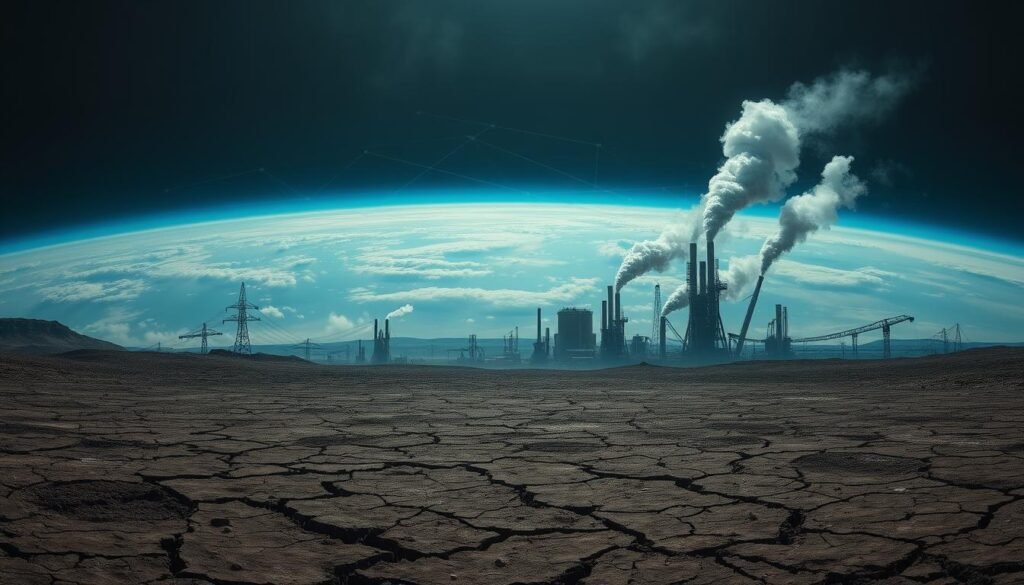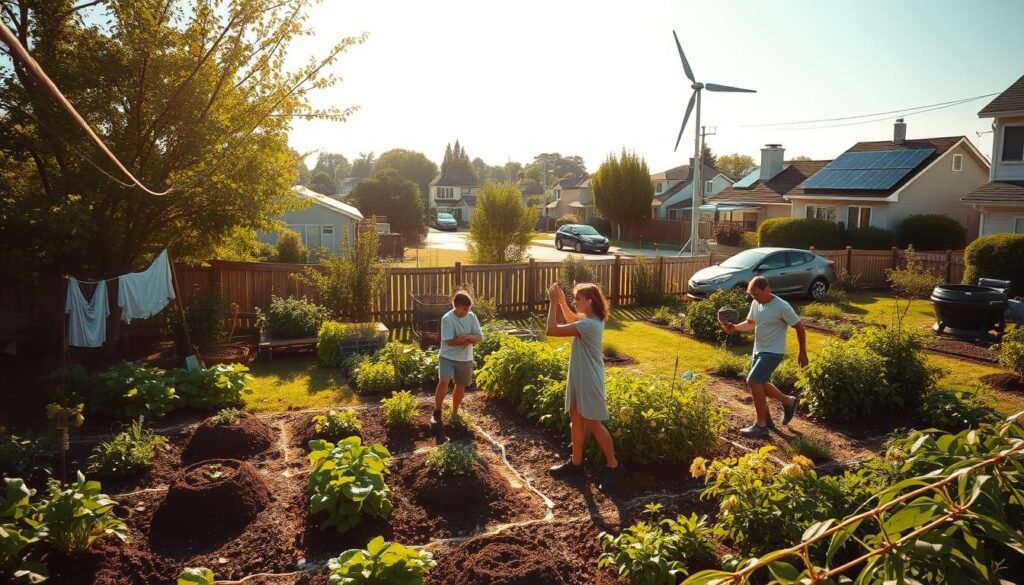What if the choices we make today could shape the world for future generations? With rising climate challenges—from extreme heatwaves to devastating floods—the need for action is clearer than ever. The United Nations defines sustainability as meeting today’s needs without sacrificing tomorrow’s resources. But how can we turn this idea into reality?
Earth Day 2024’s theme, “Planet vs. Plastics,” highlights one critical battle. Over 2.2 billion people lack safe water, and natural resources are under strain. Institutions like SNHU are stepping up, with initiatives like campus arboretums and community programs. The question isn’t just about saving the planet—it’s about rethinking how we live, work, and consume.
Key Takeaways
- Climate extremes demand urgent action to protect natural resources.
- The UN defines sustainability as balancing present and future needs.
- Earth Day 2024 focuses on reducing plastic waste globally.
- Communities and institutions play vital roles in green practices.
- Small changes today can create a lasting impact.
What Is Environmental Sustainability?
Urban water shortages could affect 2.4 billion people by 2050—how do we prevent this crisis? At its core, sustainability means meeting present needs without compromising future generations. Yet textbooks rarely address the urgency of dwindling resources like clean water.
Defining the Concept
UNESCO projects 2.4 billion urban residents will face water scarcity by 2050. This stark reality clashes with traditional definitions. True sustainability requires action, not just theory.
Pamela Beckvagni of SNHU notes: “Responsible resource management ensures ecological stability.” Her words underscore the gap between ideals and practice. Current consumption patterns already exceed Earth’s capacity.
The UN’s Perspective on Sustainability
The United Nations frames sustainability as intergenerational equity. It’s not just about needs today but securing access for tomorrow. However, systemic failures—like unequal water distribution—reveal gaps in execution.
Weinstein’s framework highlights this balance: economic activity must respect ecological limits. Without this shift, crises like water shortages will escalate.
Why Environmental Sustainability Matters
The clock is ticking—global forest loss now equals 12.8 New York Cities annually. This isn’t just about trees. It’s about the air we breathe, the water we drink, and the future we’re shaping for coming generations.
Preserving Resources for Future Generations
Earth’s forests vanish at 10 million hectares per year, while fossil fuel use outpaces regeneration by 1,000 times. Climate scientists warn these rates are unsustainable. By 2050, resource scarcity could displace millions.

SNHU’s Weinstein puts it bluntly: “Economic systems ignore environmental operating limits.” The cost of inaction? A planet unable to support human health and ecosystems.
The Planetary Boundary Concept
Nine scientific thresholds—from biodiversity loss to ocean acidification—define Earth’s safe limits. We’ve already crossed four. Global warming and chemical pollution push others to the brink.
The WHO predicts 250,000 annual climate-related deaths by 2030. Dirty air and waterborne diseases amplify the crisis. Sustainable tech may cost more now, but survival isn’t negotiable.
The Three Pillars of Sustainability
Balancing people, profit, and the planet isn’t just a slogan—it’s a blueprint for survival. The EPA’s environmental justice maps show flood risks disproportionately impact low-income communities. Meanwhile, the EU’s “polluter pays” policy holds industries accountable. These efforts reflect the three pillars: social equity, economic viability, and environmental protection.
Social Equity and Inclusion
EPA initiatives target marginalized groups, like NYC’s flood-vulnerability mapping. Social equity means fair access to resources, from clean air to disaster relief. Yet, 74% of hazardous waste sites border minority neighborhoods. Policies must bridge these gaps.
SNHU’s strategic plan includes community gardens and STEM programs. Inclusion isn’t optional—it’s how societies thrive. Without it, climate policies fail those most at risk.
Economic Viability
Circular economies reuse materials, unlike linear “take-make-waste” systems. They boost economic growth while cutting waste. For example, recycled aluminum saves 95% of production energy.
B Corps and ESG frameworks push businesses toward ethical profits. True cost accounting reveals hidden impacts, like farm runoff’s $12 billion annual cleanup cost. Profit can’t come at the planet’s expense.
Environmental Protection
Laws like the Clean Air Act enforce environmental protection. But enforcement lags—oil spills still devastate communities. The “polluter pays” principle shifts burdens to corporations.
Tech innovations help. Solar farms now power 3 million U.S. homes. Yet, systemic change needs policy and public pressure. The pillars only stand together.
How Environmental Sustainability Works
92% of students now expect universities to prioritize planet-friendly policies. This demand fuels initiatives like Southern New Hampshire University’s (SNHU) four-pillar strategic plan. It merges academics, operations, community engagement, and long-term planning into a cohesive management framework.
Balancing Ecological, Economic, and Social Goals
SNHU’s carbon neutrality roadmap targets energy consumption reductions in campus operations. Solar panel installations and waste diversion programs cut its footprint by 40% since 2010. The university aligns these efforts with economic viability—saving $1.2 million annually through efficiency upgrades.
Curriculum integration is equally critical. Degrees like Environmental Science offer flexible specializations, as noted by professor Samantha Sherwood. “Students design solutions for real-world goals,” she explains, linking theory to policy and business applications.
Case Study: SNHU’s Sustainability Strategic Plan
Materiality assessments guide SNHU’s planning, prioritizing high-impact areas like emissions and student engagement. Top-down measures (EPA compliance) meet bottom-up action, such as student-led recycling drives.
MBA programs now include sustainability concentrations, training leaders to drive carbon-conscious business models. This dual approach—systemic policy and grassroots activism—exemplifies scalable management of ecological challenges.
Individual Actions for a Sustainable Future
67% of job seekers now choose employers who prioritize green practices. This shift shows how personal values drive change. While corporations play a major role, individuals hold power through daily choices and collective advocacy.
Reducing Your Carbon Footprint
The EPA’s household emissions calculator helps measure your footprint. Switching to reusable containers cuts plastic consumption by 80% compared to single-use packaging. Small steps matter—like biking short distances or adjusting thermostats by 2°F.
Corporate footprints dwarf individual efforts. For example, snack brands generate 40% of global plastic waste. Supporting low-waste brands pressures industries to adopt greener packaging.
Advocating for Systemic Change
SNHU students showcase grassroots impact. Their recycling drives diverted 12 tons of waste yearly. Voting amplifies change—the 2022 Clean Air Act amendments passed due to youth voter turnout.
Groups like CleanHub prove innovation thrives where infrastructure fails. In Southeast Asia, they partner with locals to recover plastic before it reaches oceans. Their model blends individuals’ efforts with scalable solutions.
Every action counts. Calculate your impact, demand corporate accountability, and join community efforts. Together, these steps forge a cleaner future.
Sustainable Practices in Daily Life
3.5 million tons of waste vanish daily—yet simple home habits can reverse this trend. From NYC’s record rainfall to mismanaged trash, resource strain demands action. The good news? Cutting energy bills and water waste starts with choices we make every day.
Waste Reduction and Recycling
Not all plastic is recyclable. Resin codes 3-7 often end up in landfills despite bin placement. Check local guidelines—only #1 (PET) and #2 (HDPE) guarantee recycling success.
Vermicomposting turns kitchen scraps into fertilizer, even in apartments. Red wiggler worms process half their weight daily. Pair this with reusable containers to slash waste by 80%.
Energy and Water Conservation
EPA’s WaterSense labels expose excess: the average U.S. home uses 300 gallons daily. Fixing leaks saves 10% annually. Smart thermostats like Nest cut energy use by 15%, paying for themselves in two years.
Flood-resistant landscaping uses native plants to absorb stormwater. In climate-vulnerable areas, this reduces runoff while supporting local ecosystems. Every drop and watt counts.
Businesses and Environmental Sustainability
Corporate leaders now face a pivotal choice: adapt to green standards or risk obsolescence. The construction industry alone contributes 25% of global CO2 emissions, underscoring the urgent need for change. Forward-thinking companies are redefining success by aligning profit with planetary health.
Green Business Practices
IKEA’s shift to sustainably sourced materials contrasts sharply with fast furniture’s disposable model. Their lifecycle analysis reveals how responsible production cuts waste and builds brand loyalty. Meanwhile, Patagonia’s Worn Wear program—repairing and reselling gear—boosts profitability while slashing resource use.
Scope 3 emissions, often overlooked, include supply chain impacts. Firms like Interface Flooring tackle this through closed-loop manufacturing, recycling old carpets into new products. Such innovation reduces reliance on virgin materials and fuels long-term growth.
Benefits of Corporate Sustainability
Companies with robust green policies see 67% higher employee retention. Certifications like B Corp and LEED help consumers distinguish genuine efforts from greenwashing. These standards validate commitments to corporate sustainability, fostering trust and competitive advantage.
Interface’s model proves that eco-conscious businesses thrive. By turning waste into raw materials, they cut costs and attract investors. The lesson is clear: integrating planet-friendly practices isn’t just ethical—it’s essential for enduring success.
Renewable Energy and Technology
The world burns through 4.39 billion metric tons of oil yearly—what comes next? Record-low snowfall in the Alps (just 12% of historic averages in August 2023) signals a energy crossroads. The solution lies in technology that’s not just cleaner, but often cheaper.
Transitioning from Fossil Fuels
Solar power now costs $24-96 per MWh, undercutting coal’s $65-159 range. This price shift makes renewable energy the smart economic choice. Utilities from Texas to Germany are retiring coal plants early.
Green hydrogen faces hurdles—it requires three times more energy to produce than fossil fuels. But electrolyzer innovations could slash costs by 75% by 2030. The U.S. Inflation Reduction Act funds pilot plants to test these advances.
Innovations Driving Sustainability
Iceland’s volcanic zones power 90% of homes via geothermal technology. New drilling methods tap deeper heat sources, expanding potential globally. California’s Salton Sea projects aim to replicate this success.
Electric vehicles do more than cut tailpipe emissions. Vehicle-to-grid (V2G) systems let EV batteries supply power during peak demand. Trials in Delaware show this stabilizes grids while earning owners $400 yearly.
At NYC’s Freshkills Park, methane capture innovations turn landfill gas into electricity. Similar systems could curb 12% of global emissions from waste. The renewable energy revolution isn’t coming—it’s here.
Environmental Regulations and Policies
California’s SB 253 law proves policy drives change—mandating emissions transparency for 10,000+ businesses by 2027. From factory smokestacks to corporate boardrooms, regulations are rewriting operational playbooks. The EPA reported 1,200 Clean Air Act violations in 2023 alone, signaling tighter enforcement ahead.
The Role of the EPA
EPA penalties hit $325 million in 2024, a 42% jump from pre-pandemic levels. Their new power plant rules target nitrogen oxide cuts equivalent to taking 5 million cars off roads. Unlike voluntary corporate pledges, these regulations carry legal teeth—non-compliance can trigger daily fines up to $117,000.
The agency’s focus extends beyond penalties. Its Energy Star program helped businesses save $50 billion in energy costs since 1992. This dual approach—enforcement plus incentives—shows how management of ecological risks benefits both economy and ecosystems.
Global Sustainability Standards
While the U.S. relies on agency enforcement, the EU’s Corporate Sustainability Reporting Directive (CSRD) takes a different path. Starting in 2024, 50,000 firms must disclose supply chain impacts—from raw materials to employee commuting. This contrasts with the SEC’s narrower climate disclosure proposal for public companies.
Manufacturers face another layer through ISO 14001 certification. The process requires annual audits of waste management and pollution controls. Toyota’s certification cut landfill waste by 96%, proving global standards can drive operational excellence.
Carbon border taxes add complexity. A 2023 WTO ruling upheld the EU’s right to tax imports based on emission intensity. As policy landscapes evolve, businesses must track both local regulations and emerging global standards to maintain compliance and competitiveness.
Careers in Environmental Sustainability
The green economy is creating 10 times more jobs than fossil fuel sectors. With 7% projected growth for environmental scientists by 2033, these roles offer stability and purpose. From carbon tracking to renewable energy, careers now blend technical skills with global impact.
Top Green Jobs and Growth Areas
Environmental engineers earn $100k on average, outpacing many traditional fields. Solar project developers and carbon accountants are emerging roles, driven by climate policies. LEED certifications boost salaries by 15%, while SASB credentials open doors in corporate reporting.
SNHU alum Samantha Sherwood leveraged her degree to launch Hawaii’s first community solar program. “The skills I gained—data analysis and policy design—were instantly applicable,” she says. Her path mirrors the demand for practical education.
Educational Pathways to Sustainability Careers
SNHU’s MBA in Sustainability & Environmental Compliance bridges business and ecology. Compared to geoscience programs, it emphasizes regulatory frameworks and cost-benefit analysis. Microcredentials like LEED GA offer faster entry than four-year degrees.
Employers prioritize hands-on experience. Internships with firms like CleanHub or municipal sustainability offices provide real-world insights. The ROI? Graduates land jobs 20% faster than peers without field placements.
Conclusion
Small steps create big waves. CleanHub’s plastic recovery proves local efforts add up—diverting 12,000 tons yearly through community partnerships. Like SNHU’s arboretum, every space can become a living lab for sustainability.
Your choices matter. Audit habits with EPA tools or push for change in local policies. Future generations will judge this era by our actions, not intentions.
Progress beats perfection. Start with one practice—meatless Mondays, shorter showers, or reusable bags. Together, these shifts protect the planet while building resilient communities.
FAQ
What does environmental sustainability mean?
It refers to responsible resource use to meet current needs without harming future generations. The UN defines it as balancing economic, social, and ecological well-being.
Why is sustainability important for businesses?
Companies adopting green practices reduce costs, attract eco-conscious customers, and comply with regulations. Brands like Patagonia prove sustainability drives profit and brand loyalty.
How can individuals reduce their carbon footprint?
Simple steps like using LED bulbs, eating less meat, and choosing public transit make a difference. The EPA estimates households can cut emissions by 3,000 pounds yearly through energy conservation.
What are the fastest-growing green jobs?
Solar panel installers, wind turbine technicians, and sustainability managers top the list. The Bureau of Labor Statistics projects 8% growth in renewable energy jobs through 2030.
How does renewable energy support sustainability?
Solar, wind, and hydropower replace fossil fuels, reducing air pollution and climate impacts. Tesla’s innovations show how clean tech can scale while creating jobs.
What policies promote global sustainability?
The Paris Agreement sets emission targets, while the EPA enforces clean air/water laws. California’s carbon credit system demonstrates effective regional policy.








